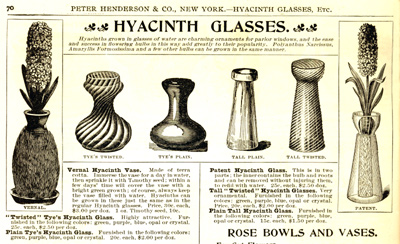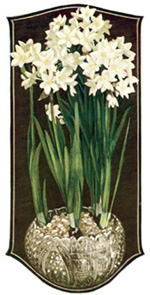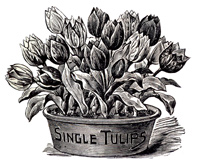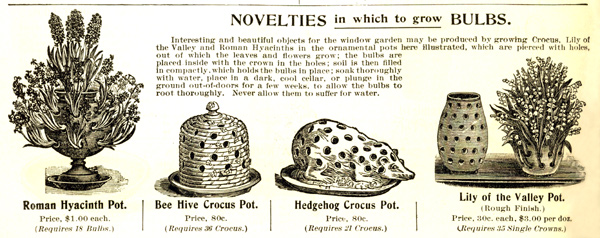It’s Easy to Coax Bulbs into Bloom All Winter Long
Forcing bulbs into winter bloom was all the rage in the 1800s. Hyacinths were especially popular, since they’re so easy. Here’s everything you need to know to start enjoying this traditional winter-time pleasure yourself.

How to Force Hyacinths the Traditional Way
Hyacinths were usually forced in special, pinch-necked vases called “hyacinth glasses” which today are more often called forcing vases. New and reproduction versions are widely available, and older ones can be found at antique shops and on eBay.

is covered with timothy grass — an antique chia pet!
To force hyacinths on water, set a bulb just above — but not touching — the water in a forcing vase or other container. Put it in a dark, cold area to root for 8-16 weeks. This could be an unheated mudroom, attic, or garage; a cold-frame; or possibly your refrigerator, though many refrigerators are too cold for optimal forcing. The temperature during this rooting period is critical: 40° to 48° F is ideal. Avoid freezing temperatures. The best way to monitor the temperature is to use a maximum-minimum thermometer available from any good garden center.
If the water gets murky, change it. When roots fill the glass and there’s an inch or two of top-growth, bring it into subdued light and warmer but still cool temperatures (about 60° F; again, a max-min thermometer will make this easy). After 7-10 days, move it into bright light, but keep it as cool as you can and avoid direct sunlight. Turn it every day to keep it growing upright.
If your hyacinth spikes start to bloom while much too short, that usually means they didn’t get enough rooting time at 48° and below — which is essential for them to develop the gibberellic acid which allows bloom stalks to lengthen. (This is Mother Nature’s clever mechanism for keeping hyacinths and other bulbs from sending up their bloom stalks during mid-winter thaws.)
How to Force Hyacinths the Impossibly Easy Way
Though experts say hyacinths won’t bloom indoors unless they root at 48° F or below for 8-16 weeks, our customers have taught us that this ain’t necessarily so. Try this: Store bulbs of ‘Lady Derby’ dry in a paper bag in your refrigerator for 8-10 weeks. Then put them on water as you would for regular forcing (see above), anywhere in indirect light. As they grow roots and leaves, give them more light but avoid direct sun. In our experience, they will bloom beautifully! We’ve also had success forcing ‘Gypsy Queen’ this way, so you may want to experiment with it, too.

on pebbles, Hunt
catalog, NYC, 1929
How to Force Narcissus on Pebbles
Tazetta narcissus are cousins to paperwhites, and almost as easy to force. The tazettas we offer include ‘Avalanche’, ‘Early Pearl’, ‘Erlicheer’, ‘Grand Primo’, and ‘Minor Monarque’.
For best results, choose a deeper bowl than for paperwhites because tazettas like more root room. Fill the bowl to within a half-inch or so of the rim with small pebbles, marbles, decorative crystals, etc. Set the bulbs on top and work them gently into the pebbles just a bit to help keep them upright. Fill the bowl with water to — ideally — just below the bottom of the bulbs. Don’t worry too much about keeping the water level below their bases, though, because the pebbles make that hard to determine and, unlike with hyacinths, it doesn’t seem to matter with tazettas.
But this is IMPORTANT: unlike paperwhites, for successful bloom tazettas must be given 2-3 weeks in the dark at temperatures below 50°F (but above freezing) so they can establish roots BEFORE they start their top-growth. And when you bring them into the light after that, they’ll do best if you continue to keep them cool, as in a Victorian parlor.
How to Force Just About Any Bulb in Pots of Soil
Forcing bulbs in pots of soil is even more fool-proof than forcing them on water, and it works with just about every kind of bulb.

1915 (image dates from 1893)
Plant bulbs close together (but not touching) just below the surface of the soil — to leave as much room as possible for rooting. For an even more lavish display, you can set one layer of bulbs just above another, alternating so that bulbs are not directly on top of one another — but combining different types of bulbs in one pot is hard to pull off successfully since rooting and blooming times vary. Arrange tulip bulbs with the flat side facing out for a more uniform display of leaves.
Water. Set in a dark, cold place for 8-16 weeks. This could be in an unheated mudroom, attic, or garage; a cold-frame; or your refrigerator, though many refrigerators are too cold for optimal forcing. The temperature during this rooting period is critical: 40° to 48° is ideal. Avoid freezing temperatures. The best way to monitor the temperature is to use a maximum-minimum thermometer available from any good garden center.
Another way to provide a cold dark place for forcing is to dig a trench a couple of feet deep — in your vegetable garden, for example — set the pots in the bottom of it on rocks or something that will provide good drainage, and cover them with at least 18 inches of straw or other mulch.
Keep pots evenly moist but not soggy. When roots show at the hole in the bottom of a pot, and top growth has begun, bring it into a cool spot — 50° to 60°F — with subdued light for a week or two. Move to a brighter spot — a window (but not into direct sun) or under fluorescent lights — but for best results continue to keep it relatively cool (as if the bulbs were outside in the spring) as buds develop and bloom.
What to Do With Forced Bulbs After They Bloom
If you keep your forced bulbs growing till spring, you can plant them outside where they will usually recover to bloom again eventually. It’s also okay to simply throw them away as you would a poinsettia or petunias at the end of the season.

For more tips and tidbits, see the Forcing Bulbs section of our Newsletter Archives.
To grow bulbs in pots for bloom OUTDOORS, see our Bulbs in Containers page.











